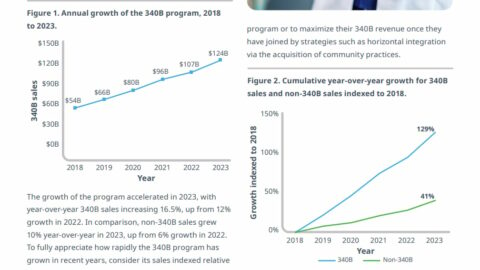There’s a long Arc today on a detailed IRA-related argument that deserves a (more) detailed response. At least, it’s long by my standards (650 words), and I feel it’s fair to warn you in the event you are not fully caffeinated.
One of the industry arguments against the IRA is that it’s going to force some difficult choices on biopharma companies.
One of those high-profile dilemmas is the idea that companies, especially those developing cancer medicines for multiple indications, will have to choose between getting a medicine approved quickly for a small indication or waiting until data is back for a larger indication.
Because time on the market is limited by the IRA, getting a quick approval for a small group may actually be disadvantageous if it limits the amount of time a company can market to a broad population.
This is a situation that’s been spelled out most clearly by Genentech.
But there was pushback on that argument this week. Writing in the New England Journal of Medicine, a team from Harvard’s PORTAL group (funded by Arnold Ventures, natch) said, “it will rarely be financially sensible for any firm to incur the cost of clinical trials and then deliberately delay the FDA approval of its product as a response to the IRA.”
While industry has its own biases, I’m inclined to trust that they know what they’re doing when it comes to revenue maximization, at least compared to a group of academics. But I think it’s worth going through the PORTAL arguments, one by one, to pressure-test their theory.
FIRST, the NEJM paper points out that waiting for a second, larger indication carries a risk that the larger indication will fail in trials. While that’s always true, pharma development groups are pretty good at accounting for those risks. What’s more, the whole quick-vs-large decision is going to take place far earlier in development, not after phase 2 trials. That’s less concrete when it comes to discussing the issue, but that’s where the rubber hits the road in terms of incentives.
SECOND, the article suggests that delaying marketing to protect Medicare sales at the end of a drug’s lifecycle means giving up opportunities in the commercial market, and delays also mean giving competitors an advantage.
But we’re talking cancer drugs here, so the Medicare market really is king. And the competitive dynamics are not that significant in those small markets usually targeted by quick approvals. So this feels like kind of a red herring.
THIRD, the PORTAL guys warn that delaying entry means burning patent life. But let’s be honest here: the IRA gives only nine years of freedom from price controls for small molecules, and the IRA cliff will arrive far before a medicine goes off patent, even if there’s a modest delay in FDA approval.
FINALLY, the paper makes an exaggerated point about the “time value of money.” Yes, discounting future cash flows is an important part of forecasting. Pharma is really good at this! It’s not clear how good the NEJM authors are. They provide a sample discount-rate calculation over a 10-year period, even though no one is talking about holding a medicine back for a decade.
I don’t mean to imply that, in every case, pharma companies are going to hold back on garnering quick approvals when there are larger indications in the wings. The NEJM analysis rightly suggests that there will be cases, maybe a lot of cases, where the math doesn’t add up.
But to imply that is a blanket description of reality — and to suggest that companies are being disingenous when they talk about this particular choice — is to show a fundamental lack of understanding about how those decisions are made, and at what point in the R&D process those decisions are made.
I’d be willing to bet there is a meeting taking place right this very moment, somewhere in New Jersey (or Cambridge or San Francisco or wherever), about the development path for some promising preclinical molecule where a plan focused on getting a quick win at the FDA are being replaced a plan to go after the big indication first.
The people in that meeting haven’t read the NEJM piece. They don’t need to. They’re living it.
Here’s a great article from STAT’s Ed Silverman that’s an efficient way to get caught up on prescription drug affordability boards. What the story doesn’t answer, however — because we don’t know yet — is exactly how big a bite these groups will take out of prices.
RSV vaccine delivery to babies is getting held up a little bit because medical practices are slow to buy vaccines before they’re confident about how reimbursement will work, according to CBS.
So Monica Bertagnolli, President Joe Biden’s pick to run the NIH, is finally going to get her hearing in front of the Senate HELP Committee. It’s scheduled for Wednesday As you’ll remember, Bernie Sanders held up her nomination because of concerns that Biden wasn’t doing enough on drug prices. My bet, though, is that Sanders isn’t done, even if he lets Bertagnolli through. I expect the hearing to veer into the topic of march-in rights, which is one of those issues that is due for some wonky fireworks (wonkyworks?) later this year.
If this email was forwarded to you, and you’d like to become a reader, click here to see back issues of Cost Curve and subscribe to the newsletter.
Plus a link to a good piece on prescription drug affordability boards Read More Cost Curve





